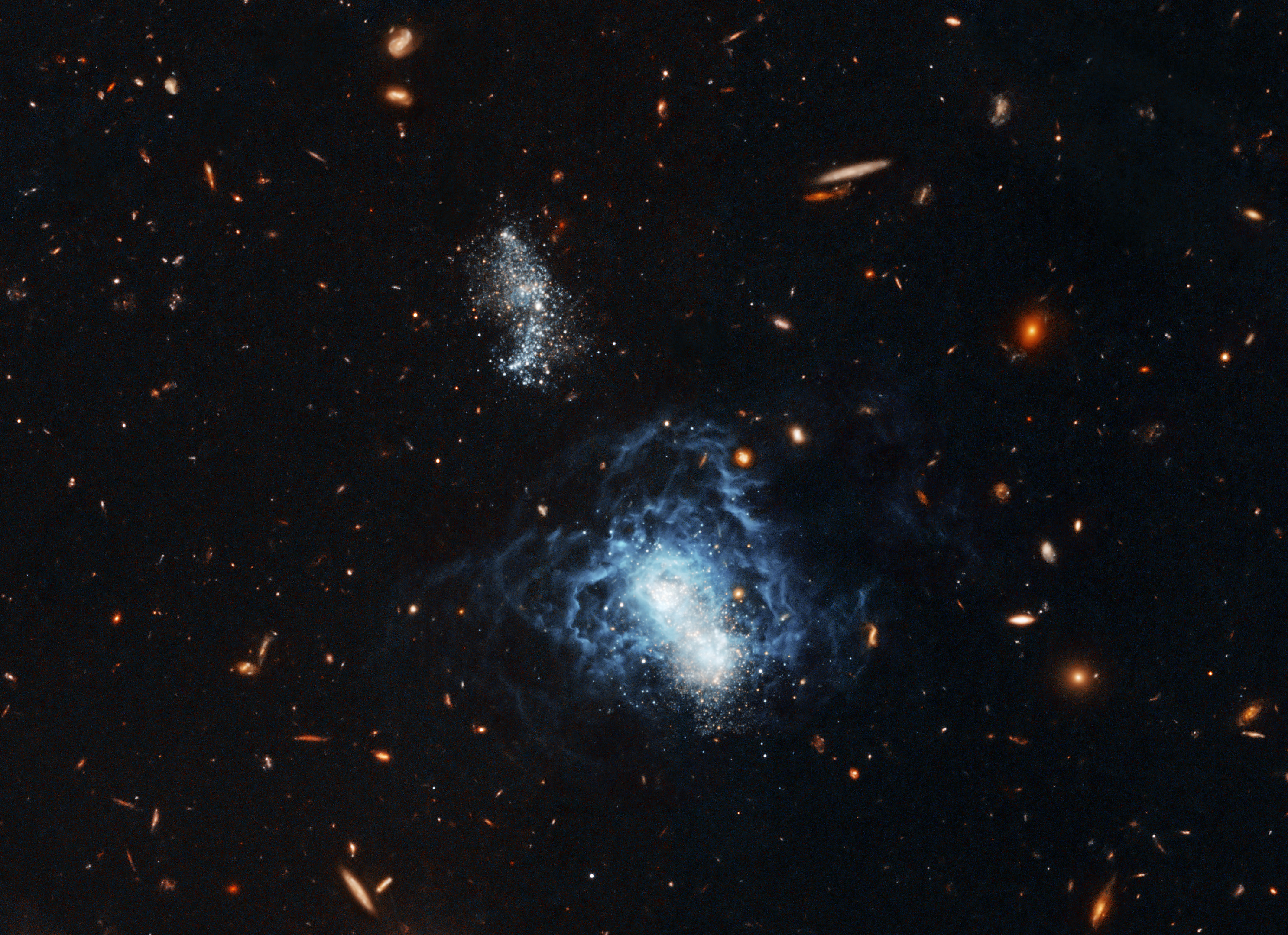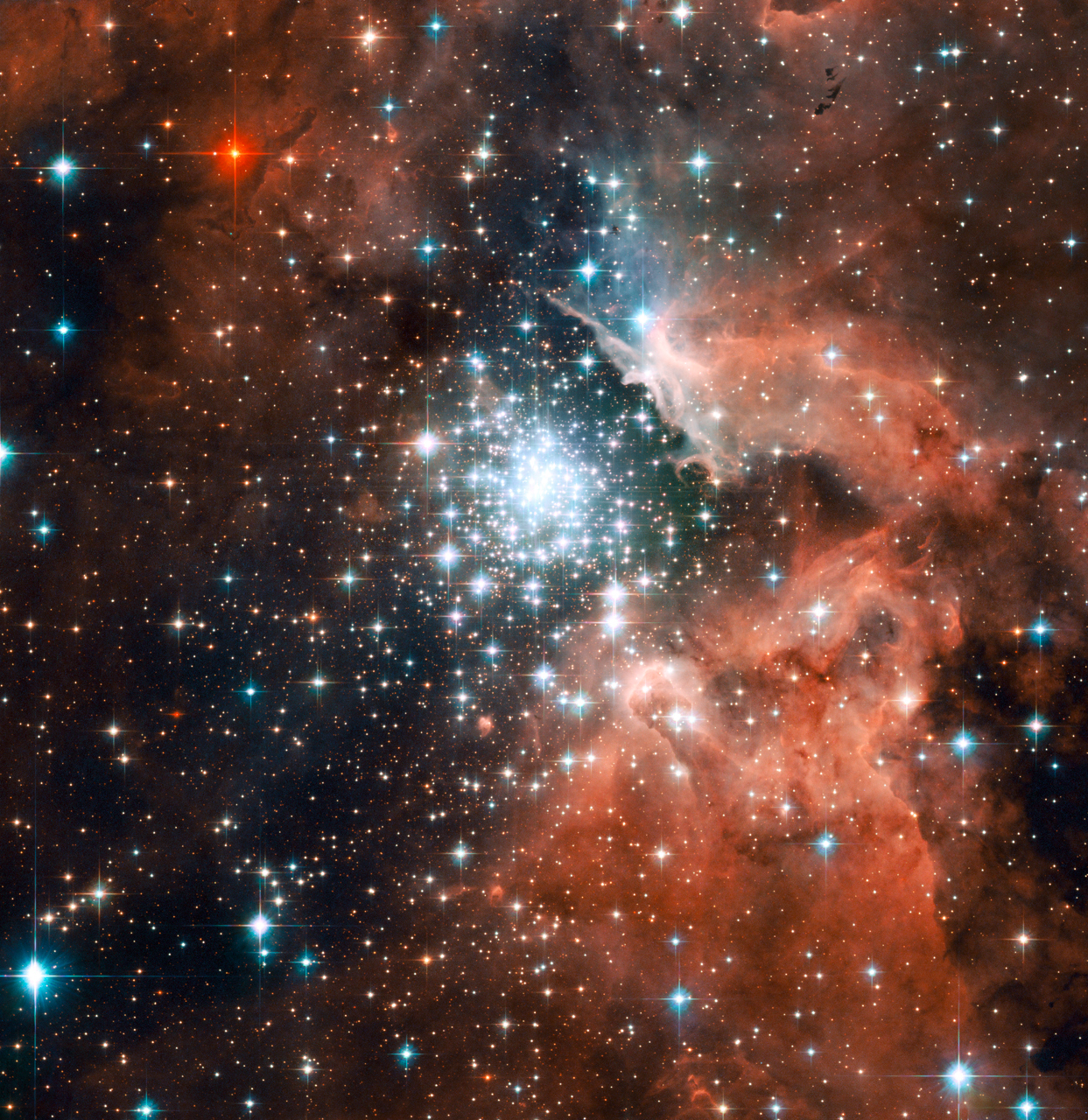 This photograph shows I Zwicky 18, until recently thought to be the youngest known galaxy in space. Some of the stars in it are only about 500 million years old, while the Sun in our solar system is about 4.5 billion years old. The Hubble Space Telescope recently took pictures that revealed that I Zwicky 18 was much older than it appeared. The pictures show that there are older stars mixed in with the bright young stars. Astronomers now believe that I Zwicky 18 is 10 billion years old. Relative to other galaxies its age, I Zwicky 18 forms new stars very frequently, explaining why it was thought to be so young. Another galaxy is visible to the right of I Zwicky 18. Astronomers think that the changes in gravitational pull between the two galaxies may be the reason for the quick star production in I Zwicky 18.
This photograph shows I Zwicky 18, until recently thought to be the youngest known galaxy in space. Some of the stars in it are only about 500 million years old, while the Sun in our solar system is about 4.5 billion years old. The Hubble Space Telescope recently took pictures that revealed that I Zwicky 18 was much older than it appeared. The pictures show that there are older stars mixed in with the bright young stars. Astronomers now believe that I Zwicky 18 is 10 billion years old. Relative to other galaxies its age, I Zwicky 18 forms new stars very frequently, explaining why it was thought to be so young. Another galaxy is visible to the right of I Zwicky 18. Astronomers think that the changes in gravitational pull between the two galaxies may be the reason for the quick star production in I Zwicky 18.
Wednesday, October 24, 2007
2.1 APOD
 This photograph shows I Zwicky 18, until recently thought to be the youngest known galaxy in space. Some of the stars in it are only about 500 million years old, while the Sun in our solar system is about 4.5 billion years old. The Hubble Space Telescope recently took pictures that revealed that I Zwicky 18 was much older than it appeared. The pictures show that there are older stars mixed in with the bright young stars. Astronomers now believe that I Zwicky 18 is 10 billion years old. Relative to other galaxies its age, I Zwicky 18 forms new stars very frequently, explaining why it was thought to be so young. Another galaxy is visible to the right of I Zwicky 18. Astronomers think that the changes in gravitational pull between the two galaxies may be the reason for the quick star production in I Zwicky 18.
This photograph shows I Zwicky 18, until recently thought to be the youngest known galaxy in space. Some of the stars in it are only about 500 million years old, while the Sun in our solar system is about 4.5 billion years old. The Hubble Space Telescope recently took pictures that revealed that I Zwicky 18 was much older than it appeared. The pictures show that there are older stars mixed in with the bright young stars. Astronomers now believe that I Zwicky 18 is 10 billion years old. Relative to other galaxies its age, I Zwicky 18 forms new stars very frequently, explaining why it was thought to be so young. Another galaxy is visible to the right of I Zwicky 18. Astronomers think that the changes in gravitational pull between the two galaxies may be the reason for the quick star production in I Zwicky 18.
Friday, October 12, 2007
1.7 APOD
 This photo contains an image of NGC 4631, or the "whale galaxy." NGC 4631 is the edge-on spiral galaxy in the top right hand corner of the photo. It is about the same size as our Milky Way. The blurry dot directly above the galaxy is called NGC 4627. The "whale galaxy" is about 30,000 kly away. It is also known as the "herring galaxy" because of it's shape. NGC 4631 has a close relationship with the other major galaxy apparent in the photo, called NGC 4656. Also known as the "hockey stick galaxy," NGC 4656 is connected to NGC 4631 by a thin branch of hydrogen gas. The "hockey stick galaxy is about 25 million ly away from Earth. Evidence shows that all three galaxies have interacted in the past.
This photo contains an image of NGC 4631, or the "whale galaxy." NGC 4631 is the edge-on spiral galaxy in the top right hand corner of the photo. It is about the same size as our Milky Way. The blurry dot directly above the galaxy is called NGC 4627. The "whale galaxy" is about 30,000 kly away. It is also known as the "herring galaxy" because of it's shape. NGC 4631 has a close relationship with the other major galaxy apparent in the photo, called NGC 4656. Also known as the "hockey stick galaxy," NGC 4656 is connected to NGC 4631 by a thin branch of hydrogen gas. The "hockey stick galaxy is about 25 million ly away from Earth. Evidence shows that all three galaxies have interacted in the past.Tuesday, October 9, 2007
Astronomer Project: Tycho Brahe
 Tycho Brahe
Tycho BraheTycho Brahe, born in 1546, was one of the most influential astronomers of all time. His observations had a huge impact on the field of astronomy. Brahe was born in Scania, now part of Sweden, to a noble family. Initially, Brahe attended the University of Copenhagen to study law, but after viewing a solar eclipse in 1560, astronomy became Brahe’s passion.
Brahe is remembered as having a rich personality. This is illustrated by an incident that occurred while he was still a university student. He had an argument with a fellow student who ended up slicing off the bridge of Brahe’s nose. To replace the missing section, Brahe began putting metal pieces there. This sparked his interest in alchemy. Another interesting anecdote from Brahe’s life involved his pet moose. Brahe had a tame moose that was generally very well-behaved. Unfortunately, however, Brahe reported that the moose died after it drank too much beer and fell down the stairs, breaking its leg.
Not only did Brahe have an exuberant personality, but he was also incredibly intelligent and driven. Born nine years prior to the invention of the telescope, Brahe made his observations with the naked eye. He also used tools of his own creation to measure angles in the sky.
Brahe made the most accurate measurements of the positions of planets and stars ever recorded at the time. One reason Brahe’s measurements were so revolutionary was that he followed celestial objects throughout their orbits. His observations led him to believe in a geocentric model of the solar system. Unlike the Ptolemaic model, Brahe thought that the Sun orbited Earth and the other planets orbited the Sun. This model pleased astronomers that felt that the Ptolemaic model was incorrect, and was also more acceptable to the Church who disapproved of the belief that the Earth orbited the Sun. The model was even adopted as the official model of the universe by the Catholic Church. Brahe believed the Earth was still because he never observed parallax, meaning he never saw a shift in relative distance between stars that were close and those that were in the background. While parallax does in fact exist, Brahe was never able to detect it because it requires extremely precise measurements.
Another contribution Brahe made to astronomy was the discovery of a new star in the constellation Cassiopeia. This finding inspired Brahe to publish his first book, titled De Stella Nova, and cemented his role as an influential astronomer. This discovery, as well as the discovery of a comet that he made five years later, was significant because it disproved Aristotle’s belief that the sky was unchanging. The star, currently known as SN 1572, is now known to be a supernova about 7500 light years away.
After hearing of Brahe’s important observations, King Frederick II of Denmark allotted a small island called Hven to Brahe on which he could build an observatory. On the island, Brahe built a castle, called Uraniborg and an observatory called Stjerneborg. Stjerneborg was mostly underground, and it was there that Brahe used the instruments for observation that he built.
One of Brahe’s assistant, Johannes Kepler, would go on to become a noted astronomer in his own right. This was largely a result of the detailed observation logs that Brahe accumulated throughout his career, passing to Kepler after his death. With Brahe’s observations, Kepler made the calculations that led him to his three laws of planetary motion.
Brahe died in Prague, the city that he eventually moved to after a dispute with King Christian IV of Denmark, on October 24, 1601. He was a noted astronomer, alchemist, and astrologer, as well as a memorable character.
Works Cited
Ferguson, Kitty. Tycho and Kepler. New York: Walker & Company, 2002.
"The Astronomer Tycho Brahe." Tychobrahe.Com. 9 Oct. 2007 <http://www.tychobrahe.com/eng_tychobrahe/index.html.>
Van Helden, Al. "Tycho Brahe." 1995. The Galileo Project. 9 Oct. 2007 <http://galileo.rice.edu/sci/brahe.html>.
Monday, October 8, 2007
Observation 1.3
Date: October 7,2007
Time: 10-10:20 PM
Location: Bee Ridge Rd. (East of the interstate)
Sky conditions: mostly clear with just a few clouds
Plantes: Jupiter was low above the horizon
Bright Stars: Antares, Altair, Vega (I couldn't tell which star was Deneb, so I was not able to identify the entire summer triagle)
Constellations noted: Delphinus, Aquila (although it was difficult to see because of the Milky Way)
Other: The moon was a waning cresent, it was barely visible; the Milky Way was also visible (at first I thought it was clouds, but it was such a defined stretch that I eventually realized it was the Milky Way)
Time: 10-10:20 PM
Location: Bee Ridge Rd. (East of the interstate)
Sky conditions: mostly clear with just a few clouds
Plantes: Jupiter was low above the horizon
Bright Stars: Antares, Altair, Vega (I couldn't tell which star was Deneb, so I was not able to identify the entire summer triagle)
Constellations noted: Delphinus, Aquila (although it was difficult to see because of the Milky Way)
Other: The moon was a waning cresent, it was barely visible; the Milky Way was also visible (at first I thought it was clouds, but it was such a defined stretch that I eventually realized it was the Milky Way)
Friday, October 5, 2007
 This picture is of NGC 3603, one of the largest star-forming regions in the Milky Way. It is 20,000 lightyears away from the Sun. NGC 3603 contains thousands of stars, many of which are larger than the Sun. The star cluster is about 20 lightyears across, and is close to the constellation, Carina. NGC 3603 is a relatively young star cluster. Some of its stars are only a million years old, while the Sun is about 5 billion years old. This picture was taken by the Hubble Space Telescope.
This picture is of NGC 3603, one of the largest star-forming regions in the Milky Way. It is 20,000 lightyears away from the Sun. NGC 3603 contains thousands of stars, many of which are larger than the Sun. The star cluster is about 20 lightyears across, and is close to the constellation, Carina. NGC 3603 is a relatively young star cluster. Some of its stars are only a million years old, while the Sun is about 5 billion years old. This picture was taken by the Hubble Space Telescope.
Subscribe to:
Posts (Atom)